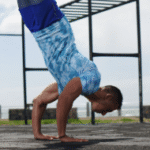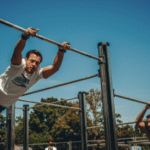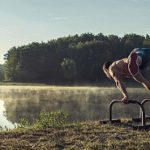Safety First: Key Considerations During Private Calisthenics
- The Indispensable Role of a Qualified and Experienced Coach
This is the paramount safety consideration in private training:
Proper Certifications: Look for trainers with reputable certifications from organizations like NASM, ACE, ACSM, NSCA, and ideally, specific calisthenics or gymnastics coaching certifications. These ensure foundational knowledge in anatomy, physiology, program design, and injury prevention.
Demonstrated Experience: A good coach has a proven track record, especially with clients who have similar goals or limitations. They’ve seen diverse body types and learned how to adapt.
Knowledge of Biomechanics and Anatomy: The coach must understand how muscles, joints, and connective tissues work together in calisthenics movements to prevent putting the body in compromising positions.
Proper Spotting Techniques: For advanced or challenging movements (e.g., handstands, muscle-ups, weighted dips), the coach must know how to spot you safely, providing just enough assistance to allow the movement while preventing falls or injuries. This is a critical advantage over self-taught methods.
Scope of Practice: A professional coach knows when to refer you to a medical professional (e.g., physical therapist, doctor) if they suspect an injury or a condition beyond their expertise.
- Thorough and Ongoing Assessment
Safety begins before the first rep, and continues throughout the training journey:
Comprehensive Initial Assessment: This is where the coach gathers vital information:
Health and Medical History: Past injuries (especially shoulders, elbows, wrists, lower back – common calisthenics injury sites), chronic conditions, surgeries, and medications.
Mobility and Flexibility Testing: Identifying limited ranges of motion that could put joints at risk (e.g., tight shoulders for overhead movements, stiff ankles for deep squats).
Strength and Muscular Imbalance Assessment: Pinpointing weak links or imbalances between opposing muscle groups that could lead to compensatory patterns and injury.
Postural Analysis: Identifying any postural deviations that need correction.
Regular Reassessment: Progress isn’t linear. The coach continuously assesses your body’s response to training, fatigue levels, and any new aches or pains to make necessary program adjustments.
- Strategic Progressive Overload and Skill Progression
The temptation to jump to advanced skills is high, but a safe coach ensures a systematic approach:
Mastering Fundamentals First: No reputable coach will let you attempt a muscle-up before you’ve mastered strong pull-ups, dips, and proper scapular control. Safety demands perfecting basic movements with pristine form.
Gradual Increase in Difficulty (Progressive Overload): Progress in calisthenics is often achieved by increasing exercise difficulty (e.g., moving from incline push-ups to regular push-ups, or from full push-ups to pseudo planche push-ups). A coach structures this progression methodically, ensuring your body is prepared for each new challenge.
Appropriate Regressions: If a movement is too difficult or causes pain, the coach will immediately regress to an easier variation that still targets the intended muscles but is safer and allows for perfect form.
Pre-requisite Skills: For complex skills, the coach breaks them down into smaller, prerequisite movements (e.g., specific core exercises for handstands, straight arm conditioning for planche) that build the necessary strength and control safely.
- Meticulous Emphasis on Form and Technique
Form is king in calisthenics, directly impacting both effectiveness and safety:
Real-time, Precise Cueing: The coach provides constant verbal and tactile cues to ensure every repetition is performed with perfect form. “Push the ground away,” “Squeeze your shoulder blades,” “Keep your core tight.”
Video Analysis: Often, a coach will record your sets and review them with you, highlighting subtle form breakdowns that you might not feel, allowing for precise corrections.
Quality Over Quantity: A safe coach will always prioritize perfect form over attempting more repetitions or a harder variation with poor technique. They understand that “ugly reps” lead to injuries.
- Proper Warm-up and Cool-down Protocols
Often overlooked, these phases are crucial for injury prevention:
Dynamic Warm-up: Before every session, the coach will lead a dynamic warm-up specifically tailored to the day’s exercises. This includes joint rotations, mobility drills, and light cardio to increase blood flow, warm up muscles, lubricate joints, and improve range of motion. (e.g., specific wrist and shoulder warm-ups for handstands).
Static Stretching/Mobility Work (Cool-down): After the workout, the coach guides static stretches and mobility exercises to improve flexibility, reduce muscle soreness, aid recovery, and help the body return to a resting state.
- Listening to Your Body and Open Communication
Safety is a shared responsibility between client and coach:
Client Communication: Clients are encouraged to communicate any pain (differentiating it from muscle fatigue), discomfort, unusual soreness, or excessive fatigue immediately.
Coach’s Observational Skills: A skilled coach can read non-verbal cues (facial expressions, hesitation, compensatory movements) that indicate discomfort or potential issues.
No Pushing Through Pain: A fundamental rule: true pain means stopping the exercise and assessing the situation. Pushing through sharp or persistent pain is a recipe for serious injury.
- Appropriate Training Environment and Equipment
The physical surroundings must be safe:
Safe Equipment: Pull-up bars, parallel bars, gymnastic rings must be sturdy, securely mounted, and in excellent condition.
Adequate Space: Enough clear space around you to perform movements safely without hitting obstacles.
Proper Flooring: Mats or suitable flooring for impact absorption, especially for skills involving drops or potential falls (e.g., handstands, muscle-ups).
Spotting Aids: Use of crash mats for higher-risk skills, especially when learning.
- Recovery and Nutrition Integration
Safety extends beyond the workout itself:
Adequate Rest and Sleep: The coach emphasizes the importance of 7-9 hours of quality sleep for muscle repair, central nervous system recovery, and hormonal balance.
Proper Hydration: Essential for joint lubrication, nutrient transport, and preventing cramps, particularly crucial in Houston’s hot and humid climate.
Nutrient-Dense Diet: Guidance on consuming enough protein for repair, carbohydrates for energy, and healthy fats for overall bodily function.
Planned Deload Weeks: Strategic periods of reduced volume and intensity to allow for full recovery and adaptation, preventing chronic fatigue and overuse injuries (common for individuals pushing themselves consistently).
Active Recovery: Light activities like walking, foam rolling, or gentle stretching on rest days to promote blood flow and recovery.
In the Houston Context:
Houston’s diverse fitness scene offers a variety of specialized calisthenics coaches. For busy professionals or anyone pursuing advanced bodyweight goals in the city, prioritizing these safety considerations in private sessions ensures that training remains effective, sustainable, and free from setbacks. Investing in a coach who meticulously prioritizes safety minimizes injury risk, accelerates skill mastery, and allows you to enjoy the long-term benefits of calisthenics without compromising your well-being.

Safety First: Key Considerations During Private Calisthenics
Route
Calisthenics Gym Houston Functional Bodyweight Training
Secondary phone: (346) 483-3195
Email: info@calisthenicsclubhouston.com
URL: https://calisthenicsclubhouston.com/
Monday 6:00 AM - 7:00 PM Tuesday 6:00 AM - 7:00 PM Wednesday 6:00 AM - 7:00 PM Thursday 6:00 AM - 7:00 PM Friday 12:00 PM - 6:30 PM Saturday 9:45 AM - 12:00 PM Sunday 3:00 PM - 5:00 PM





